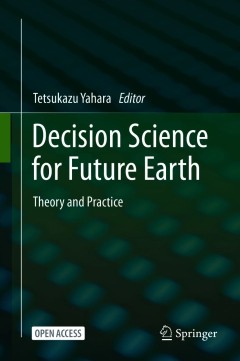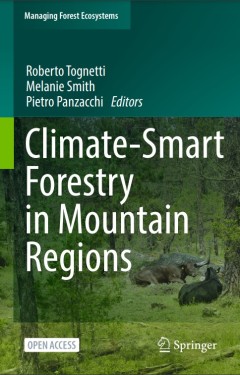Filter by

The environmental rule of law for oceans: designing legal solutions
Our oceans need a strong and effective environmental rule of law to protect them against increased pressures and demands, including climate change, pollution, fisheries, shipping and more. The environmental rule of law for oceans requires the existence of a set of rules and policies at multiple governance levels that appropriately regulate human activities at sea and ensure that pressures on th…
- Edition
- -
- ISBN/ISSN
- 9781009253741
- Collation
- xxxiii, 380 pages; illustration
- Series Title
- -
- Call Number
- 341.4 POZ t

Decision science for future Earth : theory and practice
This open access book provides a theoretical framework and case studies on decision science for regional sustainability by integrating the natural and social sciences. The cases discussed include solution-oriented transdisciplinary studies on the environment, disasters, health, governance and human cooperation. Based on these case studies and comprehensive reviews of relevant works, including l…
- Edition
- 1
- ISBN/ISSN
- 9789811586323
- Collation
- xi, 251p. : ill.
- Series Title
- -
- Call Number
- 338.927 DEC d

Rewilding European landscapes
Some European lands have been progressively alleviated of human pressures, particularly traditional agriculture in remote areas. This book proposes that this land abandonment can be seen as an opportunity to restore natural ecosystems via rewilding. We define rewilding as the passive management of ecological successions having in mind the long-term goal of restoring natural ecosystem processes.…
- Edition
- -
- ISBN/ISSN
- 9783319120393
- Collation
- xxi; 227 PG; ill.
- Series Title
- -
- Call Number
- 333.7 REW r

Architecture and fire : a psychoanalytic approach to conservation
Architecture and Fire develops a conceptual reassessment of architectural conservation through the study of the intimate relationship between architecture and fire. Stamatis Zografos expands on the general agreement among many theorists that the primitive hut was erected around fire – locating fire as the first memory of architecture, at the very beginning of architectural evolution. Follo…
- Edition
- 16
- ISBN/ISSN
- 9781787353701
- Collation
- xiv, 210p.; ill.
- Series Title
- -
- Call Number
- 720.288 ARC z

Climate-Smart Forestry in Mountain Regions
This open access book offers a cross-sectoral reference for both managers and scientists interested in climate-smart forestry, focusing on mountain regions. It provides a comprehensive analysis on forest issues, facilitating the implementation of climate objectives. This book includes structured summaries of each chapter. Funded by the EU’s Horizon 2020 programme, CLIMO has brought togethe…
- Edition
- 12
- ISBN/ISSN
- 9783030807672
- Collation
- xxiii; 574p; ill.
- Series Title
- -
- Call Number
- 634.9 CLI R

Hunting Wildlife in the Tropics and Subtropics
The hunting of wild animals for their meat has been a crucial activity in the evolution of humans. It continues to be an essential source of food and a generator of income for millions of Indigenous and rural communities worldwide. Conservationists rightly fear that excessive hunting of many animal species will cause their demise, as has already happened throughout the Anthropocene. Many specie…
- Edition
- -
- ISBN/ISSN
- 9781316338704
- Collation
- xxi, 436 p ; ill
- Series Title
- -
- Call Number
- 333.95416 HUN

What works in conservation: 2021
Does the creation of artificial reefs benefit subtidal benthic invertebrates? Is the use of organic farming instead of conventional farming beneficial to bat conservation? Does installing wildlife warning reflectors along roads benefit mammal conservation? Does the installation of exclusion and/or escape devices on fishing nets benefit marine and freshwater mammal conservation? What Works in C…
- Edition
- -
- ISBN/ISSN
- 9781800642744
- Collation
- 961 p. ; ill.
- Series Title
- -
- Call Number
- 333.9516 WIL w

Sejarah alam Gunung Sewu
Buku ini mengulas sejarah alam Gunungsewu berdasarkan hasil penelitian dari Pusat Penelitian Biologi (P2B-LIPI) yang telah 12 tahun melakukan kegiatan inventarisasi keanekaragaman hayati karst dan gua di Gunungsewu. Selain membahas aspek geologi, geomorfologi, hidrologi, dan speleologi, buku ini juga mengulas aspek hayati, baik yang ada di atas maupun di bawah permukaan. Kemudian tinjauan te…
- Edition
- -
- ISBN/ISSN
- 9786024960018
- Collation
- xvi, 141p. ; ill.
- Series Title
- -
- Call Number
- 551.447 RAH s

Conservation Biology in Sub-Saharan Africa
Conservation Biology in Sub-Saharan Africa comprehensively explores the challenges and potential solutions to key conservation issues in Sub-Saharan Africa. Easy to read, this lucid and accessible textbook includes fifteen chapters that cover a full range of conservation topics, including threats to biodiversity, environmental laws, and protected areas management, as well as related topics such…
- Edition
- -
- ISBN/ISSN
- 9781783747528
- Collation
- xxxiii, 696p,: ill
- Series Title
- -
- Call Number
- 334 JOH

Sacred heritage : monastic archaeology, identities, beliefs
Roberta Gilchrist critically evaluates the concept of sacred heritage. Drawing on global perspectives from heritage studies, archaeology, museology, anthropology and architectural history, she examines the multiple values of medieval Christian heritage. Gilchrist investigates monastic archaeology through the lens of the material study of religion and reveals the sensory experience of religion t…
- Edition
- -
- ISBN/ISSN
- 9781108678087
- Collation
- xvii, 276 p. ; ill
- Series Title
- -
- Call Number
- 274.103 GIL s
 Computer Science, Information & General Works
Computer Science, Information & General Works  Philosophy & Psychology
Philosophy & Psychology  Religion
Religion  Social Sciences
Social Sciences  Language
Language  Pure Science
Pure Science  Applied Sciences
Applied Sciences  Art & Recreation
Art & Recreation  Literature
Literature  History & Geography
History & Geography